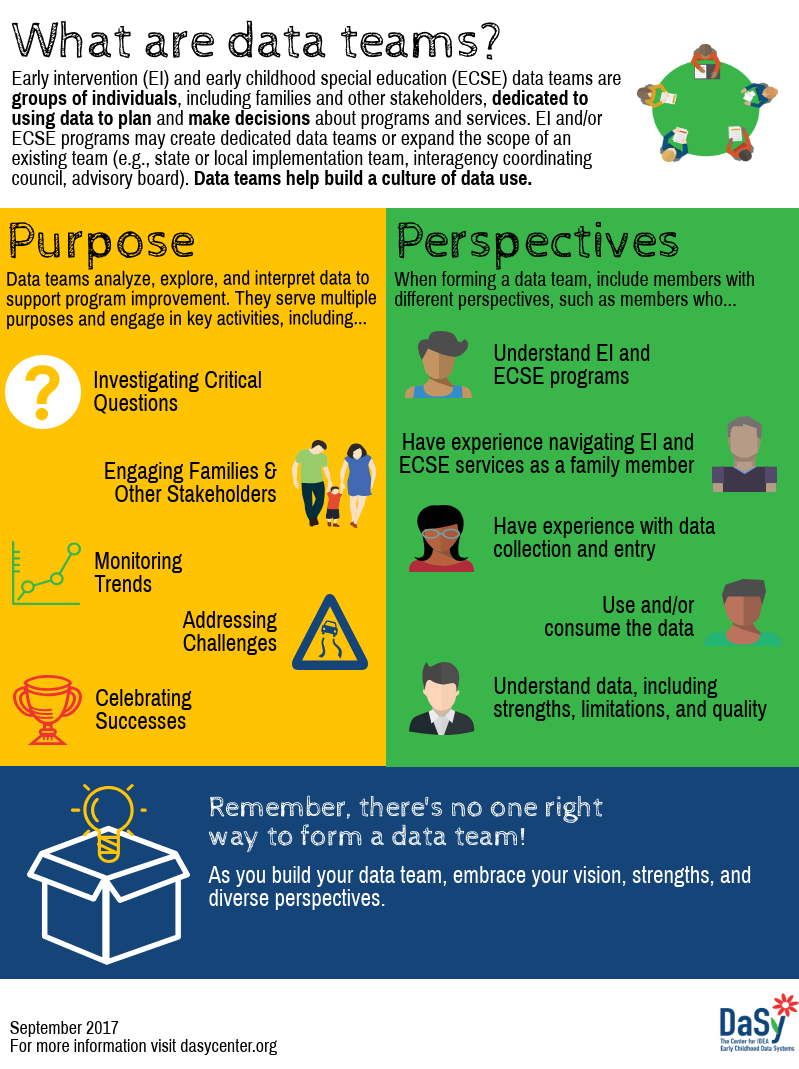The main goal of data team members is to work together to use data to plan and make decisions about programs and services. Data teams must serve multiple purposes and contribute their diverse perspectives to achieve that goal.
The infographic below presents (1) the definition of a data team, (2) the purpose data teams serve, (3) how to effectively include team members’ varied perspectives, and (4) the idea that no two data teams will have the same goals or function the same.
Download What are Data Teams Infographic or a text-only version.
Using this Infographic to Support Your Efforts
Whether starting a new internal data team or requesting support from an existing external group, this infographic can be used to do the following:
- Recruit data team members to give them an overview of data teams, how they operate and why multiple perspectives are so important to the success of the effort
- Raise awareness to gain support from leadership to start a data team
- Engage leadership on an ongoing basis about the work of the data team and to make recommendations for programmatic improvements

Purposes that data teams must serve
To be successful in building and sustaining a culture of data use, teams must serve the following purposes:
- Investigate critical questions – Knowing what questions to answer is key to understanding how programs and policies can support children’s progress. Since critical questions can be content driven (e.g., child outcomes, least restrictive environment, settings), this is often the starting point to decide who will be on the data team.
- Engage families and other stakeholders – Having a diverse set of stakeholders, including families, provides for different perspectives and experiences and thus contributes to a more robust analysis and understanding of the data. For example, parents are likely to have different questions about the data than program or school personnel.
- Monitor trends – Taking a close look at the data over time for factors such as race, geography, age of child, and disability category can provide insights into the strengths and challenges of a program.
- Address challenges – Once challenges are identified at any point in the process, it is time to develop strategies to take them on!
- Celebrate successes – Celebrating successes is a great morale booster and motivator for tackling the next round of critical questions.
Members with different perspectives should be considered when assembling a data team. Identifying critical questions and relevant data and interpreting data should be a team activity and should not be the responsibility or reflect the perspective of just one person. It is important to have those with programmatic content and data expertise come together to develop critical questions and provide context to the data analysis. When forming a data team, consider including members who:
- Understand EI and ECSE programs – Members who understand EI and ECSE programs can provide a reality check on the data (i.e., does it look right?) and provide an understanding of what the data mean.
- Have experience navigating EI and ECSE services as a family member – Families can help a data team move beyond seeing data as just numbers and trends to help them understand the environments and other factors contributing to the data.
- Have experience with IDEA data collection and data entry – Members who have experience with IDEA data collection and data entry can address issues that might arise in the data systems being used and understand the processes for entering data.
- Use and/or consume the data – Members with an interest in the data can contribute to the drill down of the data or assist with analyses.
- Drill down refers to looking at data from a more general level to a more specific (e.g., state-level data about child outcomes can be further analyzed to show local program-level of district-level data, or state-level data for all children can be further analyzed to show data by different disability types).
- Understand the data, including strengths, limitations, and quality – Members who understand or have experience with IDEA-specific data can provide expertise on the specific common data quality concerns and expected patterns in the data. It is important to understand the strengths and limitations of the employees who work with the data or on the local or state data systems and the strengths and limitations of those systems.
- Remember, there is no right way to form a data team. It is important to understand the strengths and limitations of the employees who work with the data or on the local or state data systems and the strengths and limitations of those systems.
- Teams may be initially built based on a particular question or initiative, and membership can change over time.
- Teams may have core members and switch out some members based on content or particular questions being examined.
Always remember that diverse stakeholder engagement is key to asking the right questions and understanding the findings that will inform program and policy decisions to support children and families.
Published August 2017.

